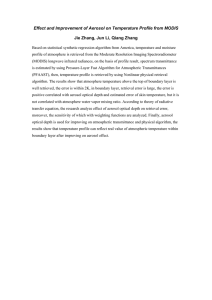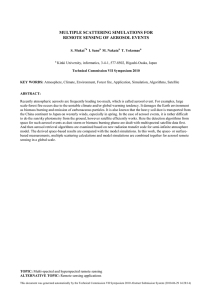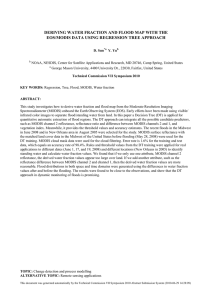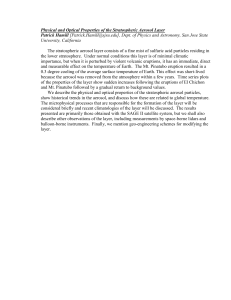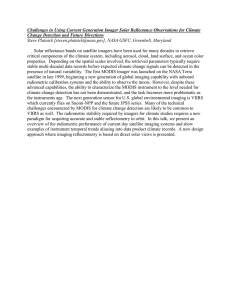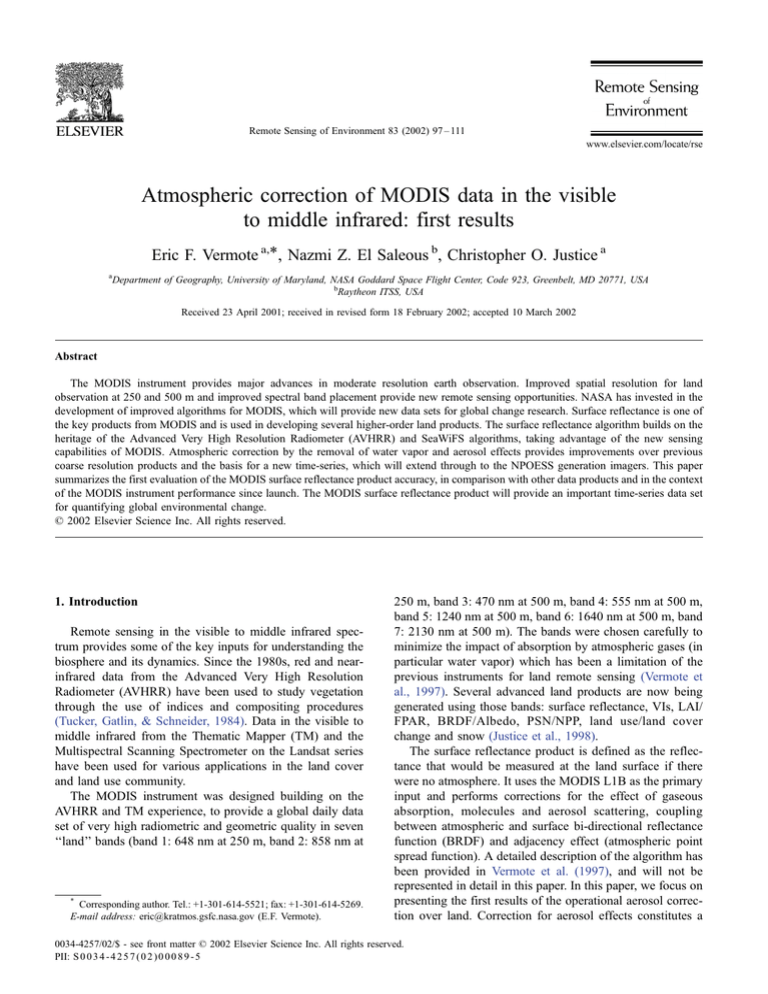
Remote Sensing of Environment 83 (2002) 97 – 111
www.elsevier.com/locate/rse
Atmospheric correction of MODIS data in the visible
to middle infrared: first results
Eric F. Vermote a,*, Nazmi Z. El Saleous b, Christopher O. Justice a
a
Department of Geography, University of Maryland, NASA Goddard Space Flight Center, Code 923, Greenbelt, MD 20771, USA
b
Raytheon ITSS, USA
Received 23 April 2001; received in revised form 18 February 2002; accepted 10 March 2002
Abstract
The MODIS instrument provides major advances in moderate resolution earth observation. Improved spatial resolution for land
observation at 250 and 500 m and improved spectral band placement provide new remote sensing opportunities. NASA has invested in the
development of improved algorithms for MODIS, which will provide new data sets for global change research. Surface reflectance is one of
the key products from MODIS and is used in developing several higher-order land products. The surface reflectance algorithm builds on the
heritage of the Advanced Very High Resolution Radiometer (AVHRR) and SeaWiFS algorithms, taking advantage of the new sensing
capabilities of MODIS. Atmospheric correction by the removal of water vapor and aerosol effects provides improvements over previous
coarse resolution products and the basis for a new time-series, which will extend through to the NPOESS generation imagers. This paper
summarizes the first evaluation of the MODIS surface reflectance product accuracy, in comparison with other data products and in the context
of the MODIS instrument performance since launch. The MODIS surface reflectance product will provide an important time-series data set
for quantifying global environmental change.
D 2002 Elsevier Science Inc. All rights reserved.
1. Introduction
Remote sensing in the visible to middle infrared spectrum provides some of the key inputs for understanding the
biosphere and its dynamics. Since the 1980s, red and nearinfrared data from the Advanced Very High Resolution
Radiometer (AVHRR) have been used to study vegetation
through the use of indices and compositing procedures
(Tucker, Gatlin, & Schneider, 1984). Data in the visible to
middle infrared from the Thematic Mapper (TM) and the
Multispectral Scanning Spectrometer on the Landsat series
have been used for various applications in the land cover
and land use community.
The MODIS instrument was designed building on the
AVHRR and TM experience, to provide a global daily data
set of very high radiometric and geometric quality in seven
‘‘land’’ bands (band 1: 648 nm at 250 m, band 2: 858 nm at
*
Corresponding author. Tel.: +1-301-614-5521; fax: +1-301-614-5269.
E-mail address: eric@kratmos.gsfc.nasa.gov (E.F. Vermote).
250 m, band 3: 470 nm at 500 m, band 4: 555 nm at 500 m,
band 5: 1240 nm at 500 m, band 6: 1640 nm at 500 m, band
7: 2130 nm at 500 m). The bands were chosen carefully to
minimize the impact of absorption by atmospheric gases (in
particular water vapor) which has been a limitation of the
previous instruments for land remote sensing (Vermote et
al., 1997). Several advanced land products are now being
generated using those bands: surface reflectance, VIs, LAI/
FPAR, BRDF/Albedo, PSN/NPP, land use/land cover
change and snow (Justice et al., 1998).
The surface reflectance product is defined as the reflectance that would be measured at the land surface if there
were no atmosphere. It uses the MODIS L1B as the primary
input and performs corrections for the effect of gaseous
absorption, molecules and aerosol scattering, coupling
between atmospheric and surface bi-directional reflectance
function (BRDF) and adjacency effect (atmospheric point
spread function). A detailed description of the algorithm has
been provided in Vermote et al. (1997), and will not be
represented in detail in this paper. In this paper, we focus on
presenting the first results of the operational aerosol correction over land. Correction for aerosol effects constitutes a
0034-4257/02/$ - see front matter D 2002 Elsevier Science Inc. All rights reserved.
PII: S 0 0 3 4 - 4 2 5 7 ( 0 2 ) 0 0 0 8 9 - 5
98
E.F. Vermote et al. / Remote Sensing of Environment 83 (2002) 97–111
siting period (1 month) and therefore the importance of their
correction prior to interpreting products derived from visible-near-infrared data.
2. Brief description of the surface reflectance algorithm
Fig. 1. Comparison of aerosol optical thickness retrieved by MODIS blue
channel with AERONET Sun photometer measurements during the April
24, 2000 to June 10, 2000 period.
first and difficult step to obtaining the surface reflectance
product. To our knowledge, these corrections have not been
applied globally and consistently to any land data set on an
operational basis. The operational correction of atmospheric
effects has been limited to Rayleigh and ozone effects on the
AVHRR Pathfinder data set (James & Kalluri, 1994). These
first results obtained by MODIS show the bias in the signal
introduced by aerosols even after a relatively long compo-
Molecular scattering, gaseous absorption and aerosols
affect the top of the atmosphere (TOA) signal measured by
the instrument. An atmospheric correction scheme based on
the 6S radiative transfer code and accounting for the surface/
atmosphere BRDF is used to compute the surface reflectance. A full description of the atmospheric correction
process is included in the MODIS surface reflectance Algorithm Theoretical Basis Document (ATBD) (Vermote &
Vermeulen, 1999) and in the paper describing the operational
algorithm and its pre-launch validation (Vermote et al.,
1997). This process can be approximated assuming a lambertian and uniform target, by the equation:
qTOA ¼TgðO3 ; O2 ; CO2 Þ qR þ ðqRþA qR ÞTgðUH2 O =2Þ
qs
þ TRþA
TgðUH2 O Þ
ð1Þ
1 qs SRþA
Where qTOA is the reflectance observed at the top of the
atmosphere, Tg refers to gaseous transmission, qR is the
molecular scattering intrinsic reflectance, qR + A is the intrinsic reflectance of the molecules and aerosols, TR + A is the
transmission of the molecules and aerosols and SR + A is the
Fig. 2. RGB image of monthly composite surface reflectance not corrected for aerosol effect over China.
E.F. Vermote et al. / Remote Sensing of Environment 83 (2002) 97–111
99
Fig. 3. RGB image of monthly composite surface reflectance corrected for aerosol effect over China.
spherical albedo. This equation accounts for the coupling
between water vapor absorption and aerosol scattering in a
simplified way (term in UH2O/2), which is of sufficient
accuracy for MODIS where the absorption by water vapor
in the visible and near-infrared bands is weak.
The atmospheric correction process currently relies on
readily available ancillary data from National Centers for
Environmental Prediction (NCEP) for the surface pressure,
ozone and water vapor content inputs, but we are planning
to use the MODIS water vapor product in the near future.
Aerosol optical thickness (AOT) represents the most critical element in the correction scheme since it has a large
effect on the visible and near-infrared bands and there is
no readily available ancillary data that can provide this
input. AOT is derived from MODIS data itself; the
retrieval approach and limitations are described in the
following sections.
have been encountered with this technique at very small
optical depths ( f 0.07) using Thematic Mapper (Wen,
Tsay, Cahalan, and Oreopoulos, 1999), the approach is very
3. MODIS at-launch aerosol algorithm results
The MODIS aerosol retrieval algorithm over land is fully
described in Kaufman et al. (1997). The approach uses
middle infrared bands (from 2.13 to 4.0 mic) where the
aerosol effect is small, to predict the reflectance in bands
where surface reflectance is small and the aerosol signal is
strong, typically blue (450 nm) and red (650 nm) wavelengths. This method was successfully applied to a number
of cases using AVHRR data (3.75 Am with 0.67 Am) and
Thematic Mapper data (2.13 Am with 0.67 and 0.47 Am)
(Ouaidrari & Vermote, 1999). Although some problems
Fig. 4. Comparison of histograms of NDVI (corrected for aerosol and
uncorrected for aerosol) observed over China (area of 1600 1120 km), the
solid curve corresponds to the aerosol corrected data, the dashed one to the
uncorrected and the small dash to the difference between uncorrected and
corrected NDVI.
100
E.F. Vermote et al. / Remote Sensing of Environment 83 (2002) 97–111
robust and has given excellent results with MODIS (Chu et
al., in preparation). The MODIS aerosol product based on
this algorithm is part of the suite of Atmosphere products
run operationally in the MODIS Adaptive Processing System (Justice et al., 2002, this issue). Prior to using this
product in the operational surface reflectance code, we
conducted an evaluation at the Surface Reflectance Science
Computing Facility (SCF).
Data collected from April 24, 2000 to May 23, 2000 were
used to test the aerosol correction. First, the aerosol optical
thickness was derived and the values screened for cloudcontaminated cases and unacceptably high spatial variability. The remaining data set was compared to the Level 1.5
(cloud screened) Aerosol Robotic Network (AERONET)
data (Holben et al., 1998). Filtering was undertaken again
based on temporal variability observed in the AERONET
data and time difference between AERONET measurements
and MODIS retrieval ( F 30 min). Fig. 1 shows that the
derived optical thickness compares extremely well with the
measurements from AERONET. The error bars on the Y-axis
represent the standard deviation of the MODIS retrieval. The
two black lines are suggestive of the accuracy of the product
(0.05 F 0.1s) which is actually much better than the accuracy predicted prior to launch (0.05 F 0.2s).
The results of the aerosol correction on the test data set are
illustrated focusing on an area over China by Figs. 2 and 3,
which are red, green, blue (RGB) images of the monthly
composite of the surface reflectance data, composited using
minimum band 3. The aerosol corrected version shows
enhancement of the signal and improvements following
aerosol correction. The quality of these images is far from
perfect, since the inputs used were coarse resolution 5-km
Fig. 5. (a) RGB image of 500-m resolution data (not corrected for aerosol effect) collected by MODIS over Louisiana on March 21, 2001 at 16:50 GMT. Note
the smoke plume indicated by the red arrow. (b) Same as (a) but this time, the 1-km aerosol correction has been applied. The smoke plume disappeared except
for area near the smoke source due to the extreme variability of the AOT near the source and the fact that the aerosol optical thickness cannot be reliably
retrieved over the fire itself. (c) Aerosol optical depth at 470 nm corresponding to the area of (a). (d) False RGB (R = 3.75 Am, G = 1.6 Am, B = 2.13 Am) of the
area of Louisiana presented in (a) – (c) showing the presence of several active fires (small red clusters, indicated by red arrows) in particular two larger clusters
at the location of the smoke sources as identified by the aerosol product.
E.F. Vermote et al. / Remote Sensing of Environment 83 (2002) 97–111
101
Fig. 5 (continued ).
data and the prototype 50-km aerosol product, resulting in a
blocky appearance to the corrected image. However, it
clearly demonstrates the effectiveness of the aerosol correction. This aerosol perturbation is important and will
adversely effect the interpretation of the land surface products if not accounted for. Fig. 4 shows the histograms of the
NDVI for China with (solid curve) and without (dashed
curve) aerosol correction and the histogram of the difference
between the two NDVIs (small dashed curve). Differences
greater than 0.10 NDVI units can be observed on this
monthly composite for about 75% of the pixels, over an
NDVI range of 0.4– 0.9.
4. Development of an improved MODIS aerosol
correction
The MODIS aerosol correction was put in operation for
data acquired after Julian day 273, 2000. Globally, it
performed well, and improved the accuracy in the downstream products, in particular the BRDF/Albedo product
suite. Two problems were identified with this product,
namely the sensitivity to snow which was sometimes confused with dark targets, since it has a low reflectance in the
middle infrared, and the limitation of the retrieval to targets
of less than 0.15 reflectance in the middle infrared (or 0.035
at 470 nm). A new version of the aerosol algorithm was
developed to address those issues. In addition to filteringout snow and extending the retrieval to brighter targets, we
also retrieved the aerosol at a much higher spatial resolution
(1 km) than the at-launch version (18 km) which enabled
correction of small, discrete aerosol features such as smoke
plumes.
Fig. 5a– c illustrates the new 1-km aerosol product used
in the correction for an area where some fires were active
and producing smoke. Fig. 5a, which was not corrected for
aerosols, shows a large smoke plume indicated by red arrow.
In Fig. 5b, which was corrected for aerosol, the smoke
102
E.F. Vermote et al. / Remote Sensing of Environment 83 (2002) 97–111
Fig. 5 (continued ).
plumes disappears and the image shows no evidence of
under or over-correction. There is some residual smoke
contamination in the vicinity of the smoke source, due to
the very high heterogeneity of the aerosols near the source
and the fact that the aerosols cannot be inverted in a reliable
way over fire since they may perturb the 2.13 Am signal.
Fig. 5c shows the aerosol optical thickness and the higher
values for the smoke plume and also evidence of two
distinct sources of smoke. By looking at the thermal
anomalies RGB (R = 3.75 Am, G = 1.6 Am, B =2.13 Am;
see Petitcolin & Vermote, 2002, this issue, for details)
presented in Fig. 5d, one can actually locate two clusters
of active fires associated with the two smoke plumes.
New tests have also been added to filter snow pixels or
partially filled snow pixels prior to the derivation of the
optical thickness. Fig. 6a –c illustrates the problem we
encountered with the at-launch aerosol algorithm. Fig. 6a
shows an RGB image of MODIS data, not corrected for
aerosol, of the southwest United States and Mexico. Some
snow is present in higher elevation areas as indicated by
the red arrows. Fig. 6b shows again the MODIS RGB
data, but this time corrected for aerosols using the atlaunch version of the aerosol retrieval algorithm. Areas
near snow are over-corrected and even saturated at 0.01
reflectance unit. Fig. 6c shows the MODIS RGB data
corrected using the new algorithm, which uses additional
criteria to filter out snow prior to derivation of optical
thickness. One can easily see that the artifact present in the
at-launch version has disappeared. The filtering of snow
relies on using band 5 (1.24 Am) in addition to the usual
snow mask. A very conservative test is applied, using the
ratio of bands 5 to 2 (1.24 Am/0.87 Am). Snow or cloud
will decrease the value of that ratio whereas snow-free
land surface will have a ratio of greater than one. This
suggested approach to filter-out such cases has been
communicated to the MODIS Aerosol team and they are
E.F. Vermote et al. / Remote Sensing of Environment 83 (2002) 97–111
103
Fig. 5 (continued ).
conducting their own evaluation prior to adopting it in the
operational aerosol algorithm.
One other important area of improvement is the extension
of the aerosol retrieval to targets of reflectance brighter than
0.035 at 0.47 Am. This improvement is illustrated by the
figure showing the RGB uncorrected for aerosol (Fig. 7a),
the RGB corrected for aerosol (Fig. 7b) and the aerosol
optical thickness used in the correction (Fig. 7c). One can see
that no visible artifacts were introduced by the correction.
The relationship used to predict the reflectance at 0.47 Am is
not solely based on the 2.13-mic channel, but is computed
for sparsely vegetated areas from the value of a ratio using
bands 2 (0.87 Am) and 5 (1.24 Am). Sparsely vegetated
bright areas are identified using an index that combines
bands 6 (1.6 Am) and 7 (2.13 Am), which is insensitive to
most aerosol types. This relationship was tested on several
AERONET sites, where surface reflectance was computed
using aerosol optical thickness derived from the sun photo-
meter measurements. Fig. 8 shows a comparison of predicted
and observed reflectance.
Optical thickness derived using the new aerosol algorithm was compared to the AERONET measurements for
selected cases over a period of 3 months (Fig. 9). The values
compare very well especially at low optical thickness, which
is important for an operational atmospheric correction
algorithm.
5. Preliminary validation of the MODIS surface
reflectance
MODIS surface reflectance was evaluated by comparing
it with Landsat 7 Enhanced Thematic Mapper (ETM+) data.
We used AERONET water vapor (2.15 cm) and aerosol
(0.12 at 550 nm) obtained from the AERONET web site
(http://aeronet.gsfc.nasa.gov:8080/), and atmospheric cor-
104
E.F. Vermote et al. / Remote Sensing of Environment 83 (2002) 97–111
E.F. Vermote et al. / Remote Sensing of Environment 83 (2002) 97–111
105
Fig. 6. (a) RGB image of MODIS data, not corrected for aerosol, of the southwest United States and Mexico, some snow is present in higher elevation areas as
indicated by the arrows. (b) RGB image of MODIS data over the same area as (a) but corrected for aerosol using the at-launch version of the aerosol retrieval
algorithm, areas near snow are over-corrected and even saturated at 0.01 reflectance unit. (c) Same as (b) but this time, the data are corrected using the new
version of the aerosol retrieval algorithm that aggressively filters out snow pixels.
rection code for Landsat Thematic Mapper described in
Ouaidrari and Vermote (1999). Prior to comparison, rigorous cloud screening was performed in both data sets. We
also filtered Thematic Mapper data to select spectrally
uniform areas of 10 10 30-m pixels for comparison with
the MODIS 250-m data and 20 20 30-m pixels for
comparison with 500-m MODIS data. Areas were selected
with a standard deviation under 10 –20%, depending on the
band. Fig. 10 shows the comparison between the two data
sets for a uniform area located on the Thematic Mapper
image of 21 18 km. The correlation between the two data
sets is high due to the fact that we eliminated most of the
uncertainty in the MODIS sub-pixel scale by the standard
deviation filtering. The dynamic range of the land reflectance is very well represented by the selected sample. The
two data sets compare extremely well both in terms of
standard deviation and slope for most bands (note band 5 is
not present on ETM+). The differences observed are well
within the range of the expected accuracy of the MODIS
surface reflectance (Vermote & Vermeulen, 1999), except
for the 2.13-Am band. Differences between MODIS and
ETM+ could be attributed not only to uncertainty in the
atmospheric correction but also to differences in the spectral
bands and also to calibration uncertainties, both of which
need to be investigated further.
The reflectance obtained from ETM+, including correction for the adjacency effect, was compared to field measurements taken with an Analytical Spectral Devices (ASD)
spectrometer at the United States Department of Agriculture
(USDA), Beltsville Agricultural Research Center. The spectra were averaged and integrated over the ETM+ spectral
band to provide validation of the ETM+ atmospherically
corrected reflectance and therefore indirectly the MODIS
surface reflectance. Measurements were collected at three
different locations (bare soil, yellow grass, and a harvested
corn field). Fig. 11a –c shows the comparison between the
surface measurements and the ETM+ surface reflectance as
a function of the central wavelength of each ETM+ band
(0.47, 0.55, 0.67, 0.87, 1.6, 2.13 Am). The error bars on the
ASD measurements represent the standard deviation computed from the spectra collected at the location (about 30
measurements).
The harvested corn site gives the best results, probably
because it is the largest uniform area (120 250 m) of the
three locations and also because the ASD measurements
show a very good uniformity at ETM+ sub-pixel levels (low
106
E.F. Vermote et al. / Remote Sensing of Environment 83 (2002) 97–111
standard deviation). Each ASD measurement corresponds to
surface area of 0.5 m in diameter. The grass site and the soil
site correspond only to a few ETM+ pixels (30 30 m
each). The soil site shows very high non-uniformity at the
ETM+ sub-pixel level but the ETM+ reflectances are still
within 1 standard deviation of the mean ASD reflectance.
Based on this limited data set, we can say that the ETM+
corrected reflectance compares very well with the ground
Fig. 7. (a) RGB image of MODIS data (not corrected for aerosol) over South Africa acquired on September 13, 2001 between 08:45 and 08:50 GMT. (b) Same
as (a), but this time, aerosol correction has been applied. (c) Aerosol optical thickness at 0.67 Am corresponding to the data of (a), the water bodies are outlined
in white and the clouds are masked in magenta.
E.F. Vermote et al. / Remote Sensing of Environment 83 (2002) 97–111
107
Fig. 7 (continued ).
measurements and exhibits no bias due to atmospheric
correction and therefore can be used to indirectly ‘‘validate’’
the MODIS reflectance product.
We also used this limited data set to examine the differences in spectral response between MODIS and ETM+
bands. Fig. 12 compares the reflectance integrated over
MODIS versus ETM+ bands for the three different sites.
The largest difference can be observed in band 3 (0.47 Am),
where MODIS surface reflectance is about 7% lower than the
corresponding ETM+ band 1. This explains some of the
differences observed at 0.47 Am in Fig. 10 (13% difference)
where for most surfaces, there is a decrease in reflectance in
the blue. A systematic adjustment between ETM+ band 1
and MODIS band 3 needs to be taken into account when
comparing both data sets. However, the difference of 12%
observed between ETM+ band 7 and MODIS band 7 could
108
E.F. Vermote et al. / Remote Sensing of Environment 83 (2002) 97–111
Fig. 7 (continued ).
not be explained by this data set. The high standard deviation
observed in the ASD measurements for that band and the
limited scope of our validation data set prevent any con-
clusive analysis and further investigation is needed. The
values of the middle infrared bands could be used to
determine if the field measurements performed at a site are
E.F. Vermote et al. / Remote Sensing of Environment 83 (2002) 97–111
109
Fig. 8. Comparison of the simulated 0.47-Am surface reflectance (X-axis)
with the actual reflectance ( Y-axis) over selected validation sites.
Fig. 10. Comparison of the surface reflectance derived from ETM+ (using
AERONET data) with the operational MODIS surface reflectance product.
representative of the ETM+ pixel as these bands are only
slightly affected by the atmosphere, mainly just in the
gaseous transmission in which one should be able to compute accurately to within 2– 3%. For example, if the average
ASD reflectance in those bands does not match the ETM+
measurements, then there is a strong indication that the site
has not been characterized properly or is too variable at the
pixel level.
In the future, we intend to apply the approach we have
taken with ETM+ in a more systematic way: (1) we derive
ETM+ surface reflectance using atmospheric correction and
Sun photometer measurements and ancillary data for atmos-
Fig. 9. Comparison of 1-km operational aerosol optical thickness retrieved
by MODIS blue channel ( f 120 matches) with AERONET sun photometer
measurements during the March, April, May 2001 period.
pheric parameters, (2) we validate ETM+ reflectance at
specific locations using ASD reflectance measurements,
(3) we compare MODIS surface reflectance to averaged
ETM+ surface reflectance over uniform areas. This strategy
could be applied to ASTER data to extend the validation to
off-nadir observations.
6. Conclusion
The first results obtained with the MODIS reflectance
product indicate that the aerosol retrieval and correction
techniques are effective and can be applied on an operational basis. They also show that the impact of aerosols on
visible and near-infrared reflectances or a combination of
those bands (e.g. NDVI) is very important, and that aerosol
effects remain in uncorrected data sets even after long
compositing periods (e.g. a month).
The aerosol retrieval algorithm has been refined and
extended to more cases , including semi-arid surfaces and
at higher spatial resolutions. Some of the incorrect retrievals, e.g. for snow, can be eliminated through better screening
prior to aerosol inversion. This new version of the algorithm
should improve further the quality of the reflectance product
particularly at the global scale and in ‘‘difficult cases’’ (e.g.
smoke plumes) and where there is a high spatial variability
in the aerosol layer.
At this time, preliminary validation indicates that the
product is well within the error bars announced in the
ATBD. This preliminary validation has enabled us to devise
specific validation techniques that can be applied in a more
systematic way. The next step in the refinement of the
MODIS surface reflectance product is to implement correction for both adjacency effects and atmosphere surface
110
E.F. Vermote et al. / Remote Sensing of Environment 83 (2002) 97–111
Fig. 12. Comparison of reflectance from the ASD measurements integrated
over MODIS band versus integrated over ETM+ band for the soil, grass and
harvested corn plots.
BRDF coupling, and their impacts on the aerosol retrieval,
which present an interesting challenge both in terms of
operational implementation and validation. High spatial
resolution data such as ETM+ or ASTER will be critical
to evaluate the adjacency effect correction and MISR/
ASTER and MODIS PM data will be useful to address
angular effects.
Acknowledgements
We would like to acknowledge all the PIs of the
AERONET sites that provide the crucial source of the data
for validation of reflectance data and derived products. We
also thank Jeff Morisette for providing the ASD data used in
this study.
References
Fig. 11. (a) Comparison of the ETM+ surface reflectance with ground
measurements (ASD) for the harvested corn plot. (b) Comparison of the
ETM+ surface reflectance with ground measurements (ASD) for the yellow
grass plot. (c) Comparison of the ETM+ surface reflectance with ground
measurements (ASD) for the soil plot.
Chu, D. A., Kaufman, Y. J., Ichoku, C., Remer, L., Tanre, D., & Holben,
B. N. (2002). Validation of the MODIS aerosol retrieval over land.
Geophys. Res. Lett., 29(12), 1 – 4 (MOD 2).
Holben, B. N., Eck, T. F., Slutsker, I., Tanre, D., Buis, J. P., Setzer, A.,
Vermote, E., Reagan, J. A., Kaufman, Y., Nakajima, T., Lavenu, F.,
Jankowiak, I., & Smirnov, A. (1998). AERONET—a federated instrument network and data archive for aerosol characterization. Remote
Sensing of Environment, 66, 1 – 16.
James, M. E., & Kalluri, S. N. V. (1994). The Pathfinder AVHRR land data
E.F. Vermote et al. / Remote Sensing of Environment 83 (2002) 97–111
set—an improved coarse resolution data set for terrestrial monitoring.
International Journal of Remote Sensing, 15(17), 3347 – 3363.
Justice, C. O., Townshend, J. R. G., Vermote, E., Wolfe, R., El Saleous, N.,
& Roy, D. (2002). Status of MODIS, its data processing and products
for terrestrial science applications. Remote Sensing of Environment, 83,
3 – 15 (this issue).
Justice, C. O., Vermote, E., Townshend, J. R. G., Defries, R., Roy, D. P.,
Hall, D. K., Salomonson, V. V., Privette, J. L., Riggs, G., Strahler, A.,
Lucht, W., Myneni, R. B., Knyazikhin, Y., Running, S. W., Nemani,
R. R., Wan, Z. M., Huete, A. R., van Leeuwen, W., Wolfe, R. E.,
Giglio, L., Muller, J. P., Lewis, P., & Barnsley, M. J. (1998). The
Moderate Resolution Imaging Spectroradiometer (MODIS): land remote sensing for global change research. IEEE Transactions on Geoscience and Remote Sensing, 36(4), 1228 – 1249.
Kaufman, Y. J., Tanre, D., Remer, L. A., Vermote, E. F., Chu, A., &
Holben, B. N. (1997). Operational remote sensing of tropospheric aerosol over land from EOS moderate resolution imaging spectroradiometer. Journal of Geophysical Research-Atmosphere, 102(D14),
17051 – 17067.
Ouaidrari, H., & Vermote, E. F. (1999). Operational atmospheric correction
of Landsat TM data. Remote Sensing of Environment, 70(1), 4 – 15.
111
Petitcolin, F., & Vermote, E. (2002). Land surface reflectance, emissivity
and temperature from MODIS middle and thermal infrared data. Remote
Sensing of Evironment, 83, 112 – 134 (this issue).
Tucker, C. J., Gatlin, J. A., & Schneider, S. R. (1984). Monitoring vegetation in the Nile delta with NOAA-6 and NOAA-7 AVHRR imagery.
Photogrammetric Engineering and Remote Sensing, 50(1), 53 – 61.
Vermote, E. F., El Saleous, N. Z., Justice, C. O., Kaufman, Y. J., Privette, J. L.,
Remer, L., Roger, J. C., & Tanre, D. (1997). Atmospheric correction of
visible to middle-infrared EOS-MODIS data over land surfaces: background, operational algorithm and validation. Journal of Geophysical
Research-Atmosphere, 102(D14), 17131 – 17141.
Vermote, E. F., Vermeulen, A. (1999). Atmospheric correction algorithm:
spectral reflectances (MOD09). AlgorithmTheoretical Background
Document available on line at http://modarch.gsfc.nasa.gov/MODIS/
ATBD/atbd_mod08.pdf.
Wen, G. Y., Tsay, S. C., Cahalan, R. F., & Oreopoulos, L. (1999).
Path radiance technique for retrieving aerosol optical thickness over
land. Journal of Geophysical Research-Atmosphere, 104(D24),
31321 – 31332.



